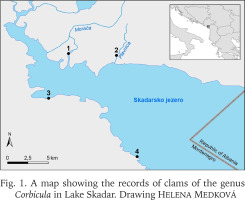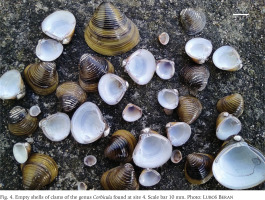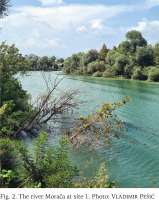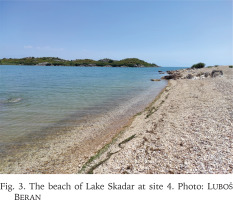The genus Corbicula Megerle von Mühlfeld, 1811, includes many freshwater and brackish species, living in lotic and lentic environments, recently native of Asian, Oceanian and African regions (Bodon et al. 2020) but fossils are also known from interglacial deposits of Europe (e.g. Ložek 1964, Meijer & Preece 2000). The taxonomy at species level is still very difficult and confusing and the number of living valid species and their identification is very uncertain. The different reproductive strategies found in Corbicula (androgenetic hermaphrodite, sexual dioecism, cross-fertilisation and self-fertilisation), as well as possible hybridisation between distinct lineages also make species delimitation problematic (reviewed in Zeng et al. 2023). More information about this problem with relevant references is given in many recent papers, e.g. Pigneur et al. 2014, Bodon et al. 2020, Morhun et al. 2022, Zeng et al. 2023. Some genetic (Pigneur et al. 2011, 2014, Zeng et al. 2023) and morphological (Morhun et al. 2022) studies show that the invasive East Asian Corbicula are two separate species: C. fluminea (O. F. Müller, 1774) and C. leana Prime, 1867. On the other hand, Bodon et al. 2020 record five species in Italy: (C. fluminalis (O. F. Müller, 1774), C. fluminea, C. cf. fluminea, C. largillierti (Philippi, 1844), C. leana).
In the Adriatic sea basin, clams of this genus have become common and widespread in Italy (especially in northen and central part) (Bodon et al. 2020) while in the Adriatic sea coast of the Balkan Peninsula they are still rare and are known only from Croatia (Beran 2020, Žganec et al. 2020).
Lake Skadar (Serbo-Croatian: Skadarsko jezero, Albanian: Ligeni I Shkodrës) is situated on the border of Albania and Montenegro. With a surface area that seasonally fluctuates between 370 km2 and 530 km2, it is the largest lake in the Balkan Peninsula (Glöer & Pešić 2008). Research on the aquatic molluscs of Lake Skadar has a long tradition and many papers about its aquatic malacofauna have been published. Most of these papers are cited in Pešić & Glöer (2018) and results of these researchs are summarised there, including the checklist of aquatic molluscs occurring in the Lake Skadar basin. No species of the genus Corbicula are included in this checklist.
In 2017, the second author accidentally found an empty shell belonging to the genus Corbicula at two sites in the northwestern part of Lake Skadar – in the river Morača at its inflow into the lake and in the river Plavnica also at its inflow into Lake Skadar (loc. 1 and 2 in Table 1 and Figs 1–2). Shells were identified as C. fluminea, and based on these findings this species was included in the list of species occurring in the Lake Skadar basin without any additional information (Raković et al. 2020). These records prompted a survey in 2022. During this survey specimens and empty shells were searched for by washing sediments using a metal sieve (diameter 20 cm, 0.8 mm mesh) combined with hand-collecting and snorkelling in shallow parts (up to ca. 3 m deep).
Table 1
The list of studied sites. The data are sorted as follows: site number, geographical coordinates, location and description of the site, number of live specimens and empty shells, date and finder (LB – Luboš Beran, VB – Václav Beran, VP – Vladimir Pešić).

Fig. 1
A map showing the records of clams of the genus Corbicula in Lake Skadar. Drawing Helena Medková

The occurrence of clams of the genus Corbicula was confirmed in the river Morača at its inflow into the lake near Vranjina (loc. 1 in Table 1 and Figs 1–2). Two other sites were found on the southwestern shores of Lake Skadar near Godinje (loc. 3 in Table 1 and Fig. 1) and Donji Murići (loc. 4 in Table 1 and Figs 1, 3). Only one empty shell had been found at each site in 2017, while several empty shells and also living specimens were found at the first site in 2022 in the shallow part of this river with gravel-sand sediment. More abundant populations were found at two other sites near Godinje and Donji Murići. Clams were recorded in the gravel-sand and sand sediment in shallow places (depth approx. 0.5–1.5 m). A scattered occurrence of live individuals was documented there and density was about 10 individuals per 1 m2 or lower. There was also a scattered occurrence of empty shells. No clams were found in deeper parts (approximately deeper than 1.5 m) with more fine sediment.
Dimensions of the collected specimens and shells (Fig. 4) varied from 7 to 37 mm (length) and from 6.5 to 31 mm (height). The shape of shells was oval-subtriangular and asymmetrical especially in the case of bigger specimens. The umbo was prominent with a narrow bluish vertical band (especially in younger specimens); inner valves were pale (whitish or pale violet) and lateral teeth had purple spot at the base. The specimens and shells correspond with C. fluminea as described by Bodon et al. (2020) (see their fig. 7), and also look like a widespread invasive morphotype, which in Europe is called “form R” and in America “form A” and is correlated with C. leana (Pigneur et al. 2011, Morhun et al. 2022). Selected shells and ethanol-preserved specimens are deposited in the first author‘s collection.
Fig. 4
Empty shells of clams of the genus Corbicula found at site 4. Scale bar 10 mm. Photo: Luboš Beran

The occurrence of clams of the genus Corbicula was also investigated at other suitable sites in the Lake Skadar basin in 2022 but clams were not found. Coordinates of these sites are as follows:
Our findings, together with the absence of earlier data on the occurrence, indicate a recent invasion of these non-native clams into Lake Skadar. However, taking into account the findings in different parts of the lake, it can be assumed that these clams are probably more widespread also in other suitable places, including the Albanian part of the lake. The density is currently low and it does not seem to have an important negative effect on the unique communities found here. However, due to possible negative impacts to molluscan assemblages in the future it is desirable to monitor the further spread and probable population increase of this non-native and invasive clam in Lake Skadar.



